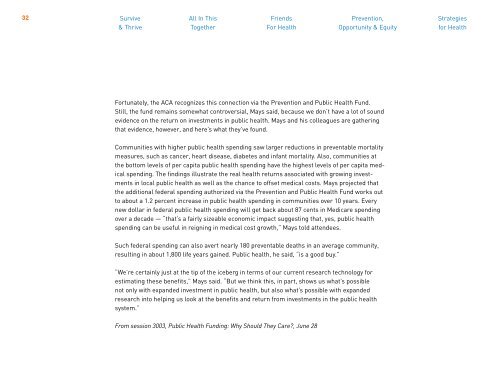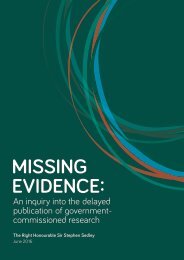INSIGHT & INSPIRATION FROM APHA’S 2012 MIDYEAR MEETING
INSIGHT & INSPIRATION FROM APHA’S 2012 MIDYEAR MEETING
INSIGHT & INSPIRATION FROM APHA’S 2012 MIDYEAR MEETING
You also want an ePaper? Increase the reach of your titles
YUMPU automatically turns print PDFs into web optimized ePapers that Google loves.
32<br />
Survive All In This Friends Prevention, Strategies<br />
& Thrive Together For Health Opportunity & Equity for Health<br />
Fortunately, the ACA recognizes this connection via the Prevention and Public Health Fund.<br />
Still, the fund remains somewhat controversial, Mays said, because we don’t have a lot of sound<br />
evidence on the return on investments in public health. Mays and his colleagues are gathering<br />
that evidence, however, and here’s what they’ve found.<br />
Communities with higher public health spending saw larger reductions in preventable mortality<br />
measures, such as cancer, heart disease, diabetes and infant mortality. Also, communities at<br />
the bottom levels of per capita public health spending have the highest levels of per capita medical<br />
spending. The findings illustrate the real health returns associated with growing investments<br />
in local public health as well as the chance to offset medical costs. Mays projected that<br />
the additional federal spending authorized via the Prevention and Public Health Fund works out<br />
to about a 1.2 percent increase in public health spending in communities over 10 years. Every<br />
new dollar in federal public health spending will get back about 87 cents in Medicare spending<br />
over a decade — “that’s a fairly sizeable economic impact suggesting that, yes, public health<br />
spending can be useful in reigning in medical cost growth,” Mays told attendees.<br />
Such federal spending can also avert nearly 180 preventable deaths in an average community,<br />
resulting in about 1,800 life years gained. Public health, he said, “is a good buy.”<br />
“We’re certainly just at the tip of the iceberg in terms of our current research technology for<br />
estimating these benefits,” Mays said. “But we think this, in part, shows us what’s possible<br />
not only with expanded investment in public health, but also what’s possible with expanded<br />
research into helping us look at the benefits and return from investments in the public health<br />
system.”<br />
From session 3003, Public Health Funding: Why Should They Care?, June 28



